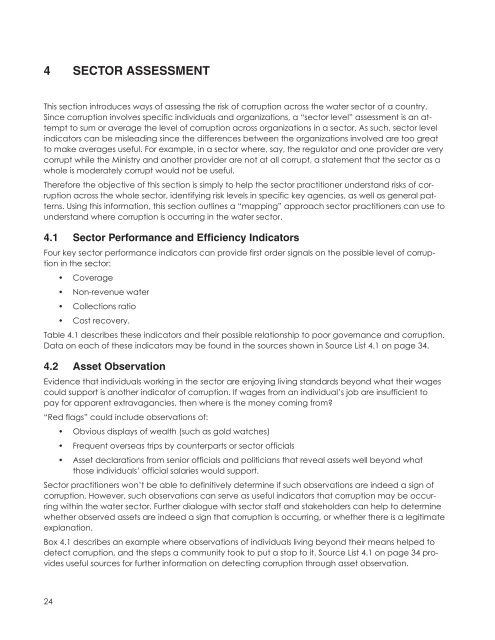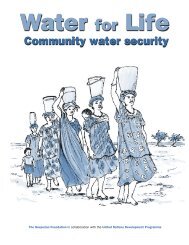A Sourcebook - UN-Water
A Sourcebook - UN-Water
A Sourcebook - UN-Water
You also want an ePaper? Increase the reach of your titles
YUMPU automatically turns print PDFs into web optimized ePapers that Google loves.
4 SECTOR ASSESSMENT<br />
This section introduces ways of assessing the risk of corruption across the water sector of a country.<br />
Since corruption involves specific individuals and organizations, a “sector level” assessment is an attempt<br />
to sum or average the level of corruption across organizations in a sector. As such, sector level<br />
indicators can be misleading since the differences between the organizations involved are too great<br />
to make averages useful. For example, in a sector where, say, the regulator and one provider are very<br />
corrupt while the Ministry and another provider are not at all corrupt, a statement that the sector as a<br />
whole is moderately corrupt would not be useful.<br />
Therefore the objective of this section is simply to help the sector practitioner understand risks of corruption<br />
across the whole sector, identifying risk levels in specific key agencies, as well as general patterns.<br />
Using this information, this section outlines a “mapping” approach sector practitioners can use to<br />
understand where corruption is occurring in the water sector.<br />
4.1 Sector Performance and Efficiency Indicators<br />
Four key sector performance indicators can provide first order signals on the possible level of corruption<br />
in the sector:<br />
• Coverage<br />
• Non-revenue water<br />
• Collections ratio<br />
• Cost recovery.<br />
Table 4.1 describes these indicators and their possible relationship to poor governance and corruption.<br />
Data on each of these indicators may be found in the sources shown in Source List 4.1 on page 34.<br />
4.2 Asset Observation<br />
Evidence that individuals working in the sector are enjoying living standards beyond what their wages<br />
could support is another indicator of corruption. If wages from an individual’s job are insufficient to<br />
pay for apparent extravagancies, then where is the money coming from?<br />
“Red flags” could include observations of:<br />
• Obvious displays of wealth (such as gold watches)<br />
• Frequent overseas trips by counterparts or sector officials<br />
• Asset declarations from senior officials and politicians that reveal assets well beyond what<br />
those individuals’ official salaries would support.<br />
Sector practitioners won’t be able to definitively determine if such observations are indeed a sign of<br />
corruption. However, such observations can serve as useful indicators that corruption may be occurring<br />
within the water sector. Further dialogue with sector staff and stakeholders can help to determine<br />
whether observed assets are indeed a sign that corruption is occurring, or whether there is a legitimate<br />
explanation.<br />
Box 4.1 describes an example where observations of individuals living beyond their means helped to<br />
detect corruption, and the steps a community took to put a stop to it. Source List 4.1 on page 34 provides<br />
useful sources for further information on detecting corruption through asset observation.<br />
24
















